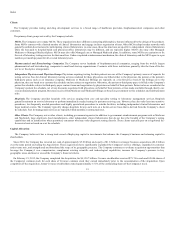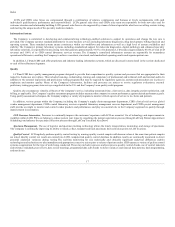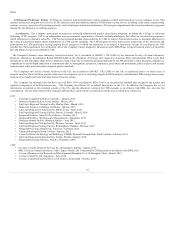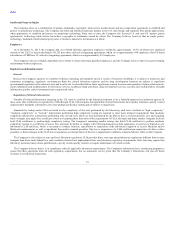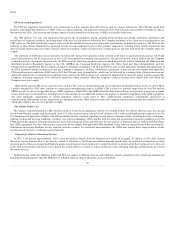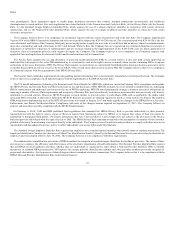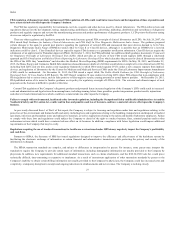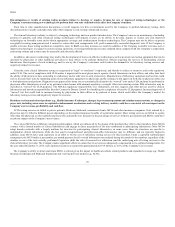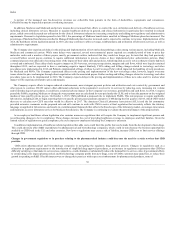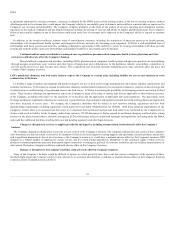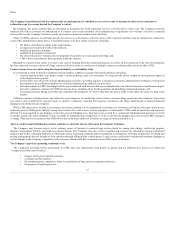LabCorp 2015 Annual Report Download - page 24
Download and view the complete annual report
Please find page 24 of the 2015 LabCorp annual report below. You can navigate through the pages in the report by either clicking on the pages listed below, or by using the keyword search tool below to find specific information within the annual report.
Index
testing, both the clinical laboratory and the healthcare provider (e.g., physician) may be liable under the Anti-Kickback Statute, and may be subject to
criminal prosecution and exclusion from participation in the Medicare and Medicaid programs. More recently, in June 2014, the OIG issued another Special
Fraud Alert addressing compensation paid by laboratories to referring physicians for blood specimen processing and for submitting patient data to registries.
This Special Fraud Alert reiterates the OIG's long-standing concerns about payments from laboratories to physicians in excess of the fair market value of the
physician's services and payments that reflect the volume or value of referrals of federal U.S. program business.
Another issue the OIG has expressed concern about involves the provision of discounts on laboratory services billed to customers in return for the referral
of U.S. healthcare program business. In a 1999 Advisory Opinion, the OIG concluded that a proposed arrangement whereby a laboratory would offer
physicians significant discounts on non-U.S. healthcare program laboratory tests might violate the Anti-Kickback Statute. The OIG reasoned that the
laboratory could be viewed as providing such discounts to the physician in exchange for referrals by the physician of business to be billed by the laboratory
to Medicare at non-discounted rates. The OIG indicated that the arrangement would not qualify for protection under the discount safe harbor to the Anti-
Kickback Statute because Medicare and Medicaid would not get the benefit of the discount. Similarly, in a 1999 correspondence, the OIG stated that if any
direct or indirect link exists between a discount that a laboratory offers to a skilled nursing facility for tests covered under Medicare’s payments to the skilled
nursing facility and the referral of tests billable by the laboratory under Medicare Part B, then the Anti-Kickback Statute would be implicated.
The OIG also has issued guidance regarding joint venture arrangements that may be viewed as suspect under the Anti-Kickback Statute. These
documents have relevance to clinical laboratories that are part of (or are considering establishing) joint ventures with potential sources of U.S. healthcare
program business. The first guidance document, which focused on investor referrals to such ventures was issued in 1989 and another concerning contractual
joint ventures was issued in April 2003. Some of the elements of joint ventures that the OIG identified as “suspect” include: arrangements in which the
capital invested by the physicians is disproportionately small and the return on investment is disproportionately large when compared to a typical
investment; specific selection of investors who are in a position to make referrals to the venture; and arrangements in which one of the parties to the joint
venture expands into a line of business that is dependent on referrals from the other party (sometimes called “shell” joint ventures). In a 2004 advisory
opinion, the OIG expressed concern about a proposed joint venture in which a laboratory company would assist physician groups in establishing off-site
pathology laboratories. The OIG indicated that the physicians' financial and business risk in the venture was minimal and that the physicians would contract
out substantially all laboratory operations, committing very little in the way of financial, capital, or human resources. The OIG was unable to exclude the
possibility that the arrangement was designed to permit the laboratory to pay the physician groups for their referrals, and, therefore, was unwilling to find that
the arrangement fell within a safe harbor or had sufficient safeguards to protect against fraud or abuse.
Violations of other fraud and abuse laws can also result in exclusion from participation in U.S. healthcare programs, including Medicare and Medicaid.
One basis for such exclusion is an individual or entity’s submission of claims to Medicare or Medicaid that are substantially in excess of that individual or
entity’s usual charges for like items or services. In 2003, the OIG issued a notice of proposed rulemaking that would have defined the terms “usual charges”
and “substantially in excess” in ways that might have required providers, including LCD, to either lower their charges to Medicare and Medicaid or increase
charges to certain other payers to avoid the risk of exclusion. On June 18, 2007, however, the OIG withdrew the proposed rule, saying it preferred to continue
evaluating billing patterns on a case-by-case basis. In its withdrawal notice, the OIG also said it “remains concerned about disparities in the amounts charged
to Medicare and Medicaid when compared to private payers,” that it continues to believe its exclusion authority for excess charges “provides useful backstop
protection for the public fisc from providers that routinely charge Medicare or Medicaid substantially more than their other customers” and that it will
continue to use “all tools available … to address instances where Medicare or Medicaid are charged substantially more than other payers.” Thus, although
the OIG did not proceed with its rulemaking, an enforcement action under this statutory exclusion basis is possible and, if pursued, could have an adverse
effect on the Company. The enforcement by Medicaid officials of similar state law restrictions also could have a material adverse effect on the Company.
Under another U.S. statute, known as the Stark Law or “self-referral” prohibition, physicians who have a financial or a compensation relationship with a
clinical laboratory may not, unless an exception applies, refer Medicare patients for testing to the laboratory, regardless of the intent of the parties. Similarly,
laboratories may not bill Medicare for services furnished pursuant to a prohibited self-referral. There are several Stark Law exceptions that are relevant to
arrangements involving clinical laboratories, including: i) fair market value compensation for the provision of items or services; ii) payments by physicians
to a laboratory for clinical laboratory services; iii) an exception for certain ancillary services (including laboratory services) provided within the referring
physician's own office, if certain criteria are satisfied; iv) physician investment in a company whose stock is traded on a public exchange and has stockholder
equity exceeding $75.0 million; and v) certain space and equipment rental arrangements that are set at a fair market value rate and satisfy other requirements.
All of the requirements of a Stark Law exception must be met in order for the exception to apply. Many states have their own self-referral laws as well, which
in some cases apply to all patient referrals, not just Medicare.
24



